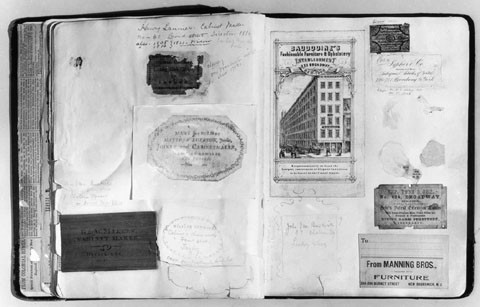
Two pages from a scrapbook compiled by Ernest F. Hagen, New York City, 1892–1906. Included are clippings of newspaper articles quoting Hagen and labels of New York cabinetmakers, removed from furniture that Hagen apparently restored and/or sold. (Courtesy, Museum of the City of New York, gift of Bernard & S. Dean Levy, Inc., and Mr. and Mrs. Benjamin Ginsburg; photo, Helga Studio.)

Card table with a partially legible paper label of Meier and Hagen (active 1858–1888), New York City, 1885–1888. Mahogany and mahogany veneer. H. 30", W. 39 1/4", D. 19 1/4". (Courtesy, New York State Museum, gift of The Wunsch Foundation; photo, Gavin Ashworth.)

Detail of the support on the card table illustrated in fig. 2. (Photo, Gavin Ashworth.)

Dressing glass, American or English, 1790–1810; labeled by Meier and Hagen, with “Meier” crossed out in ink, ca. 1890; Mahogany, mahogany veneer, and lightwood stringing with pine. H. 20 1/2", W. 21 3/4", D. 18 1/2". (Courtesy, The Collection of the Newark Museum, gift of John Babcock Morris; photo, Gavin Ashworth.)
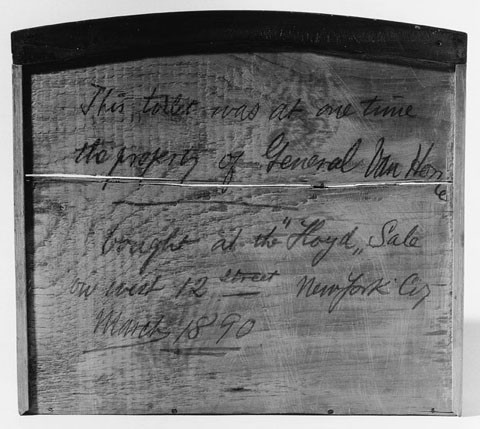
Detail of the inscription on the drawer of the dressing glass illustrated in fig. 4. (Photo, Gavin Ashworth.)

Detail of the label on the dressing glass illustrated in fig. 4. (Photo, Gavin Ashworth.)

Dressing glass attributed to Duncan Phyfe, New York City, after 1847. Mahogany and mahogany veneer. H. 19 9/16", W. 12 1/4", D. 9 7/8". (Private collection, on loan to the Museum of the City of New York; photo, Helga Studio.)

“Old New York Furniture,” New York Sun, August 12, 1894; from a scrapbook compiled by Ernest F. Hagen, 1892–1906. (Courtesy, Museum of the City of New York, gift of Bernard & S. Dean Levy, Inc., and Mr. and Mrs. Benjamin Ginsburg; photo, Helga Studio.)

Card table (one of two) labeled by Ernest F. Hagen (1830–1913), New York City, 1890–1905. Mahogany and rosewood and birch veneer with pine. H. 30 5/16", W. 36 1/8", D. 17 7/8" (closed). (Courtesy, Museum of the City of New York, gift of Mrs. Harry Horton Benkard; photo, Gavin Ashworth.)

Detail of the underside of the table illustrated in fig. 9. (Photo, Gavin Ashworth.)

Card table labeled by John T. Dolan (1805–1815), New York City, 1809–1813. Mahogany and mahogany veneer with white pine and cherry. H. 30 1/8", W. 35 3/4", D. 36 5/16" (open). (Courtesy, Museum of the City of New York, gift of Doctors C. Ray and Winifred Hope Franklin; photo, Gavin Ashworth.)
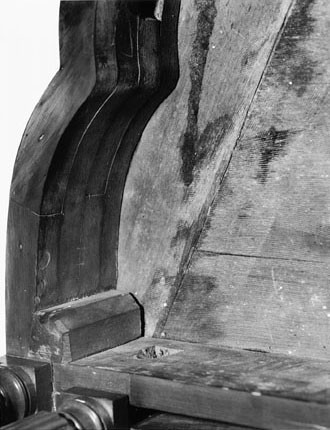
Detail of the underside of the table illustrated in fig. 11. (Photo, Gavin Ashworth.)

Sofa, New York City, 1810–1815; restored by the shop of Ernest F. Hagen, 1922. Mahogany with tulip poplar and pine. H. 37 3/16", W. 79 15/16", D. 25". (Courtesy, Museum of the City of New York, gift of Mrs. Harry Horton Benkard; photo, Gavin Ashworth.)

“The Company of Master Craftsmen, Inc./Duncan Phyfe Furniture,” W. & J. Sloane advertisement, Antiques 10, no. 3 September 1926): 156. (Courtesy, Museum of the City of New York; photo, Helga Studio.)

“The Monticello-A Duncan Phyfe Adaptation,” Sears, Roebuck and Co. catalogue, Spring-Summer 1930, p. 576. Naming the dining room suite “The Monticello” linked the “livable period reproductions” with statesman and politician Thomas Jefferson, thereby enhancing its symbolic value. (Courtesy, Museum of the City of New York; photo, Helga Studio.)
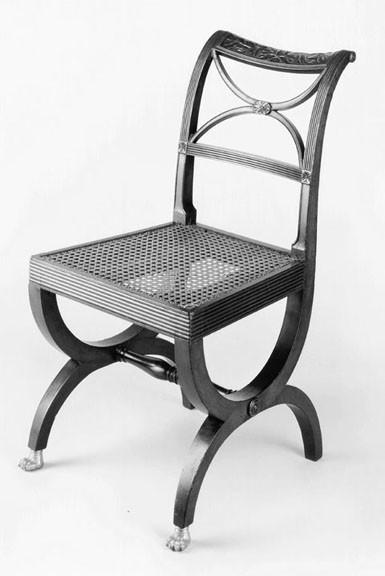
Curule side chair, New York City, 1810–1815; inscribed in ink on the inside of the front seat rail: “Thomas Cornell Pearsall made/for him by Duncan Phyfe.” Mahogany. H. 32 5/8", W. 17 3/4", D. 16 1/4". (Courtesy, Museum of the City of New York, gift of C. Ruxton Love; photo, Gavin Ashworth.)

Curule side chair labeled by Henry Dorr (1842/43–1862/63), New York City, 1842–1863. Mahogany. H. 32 5/8", W. 17 3/4", D. 16 1/4". (Courtesy, Museum of the City of New York, gift of C. Ruxton Love; photo, Gavin Ashworth.)
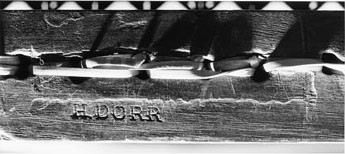
Detail of the “H. DORR” brand on the rail of the side chair illustrated in fig. 17. (Photo, Gavin Ashworth.)
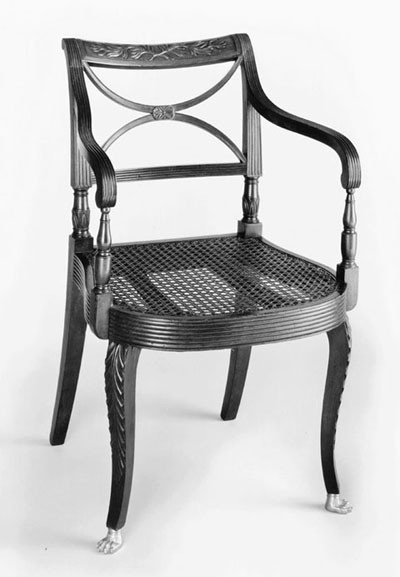
Armchair (one of two), New York City, ca. 1815. Mahogany. H. 33", W. 20 5/8", D. 17 15/16". (Courtesy, Museum of the City of New York, gift of Captain Marion Eppley, U.S.N. Ret., in honor of John Walden Myer; photo, Gavin Ashworth.)
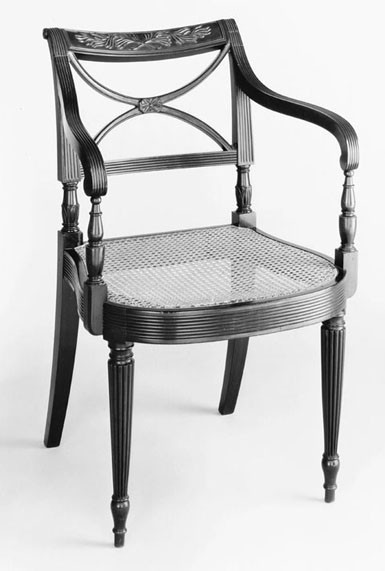
Scroll-back armchair labeled by Ernest F. Hagen, New York City, 1905. Mahogany. H. 31", W. 19 3/4", D. 17 3/4". (Private collection; photo, Gavin Ashworth.)
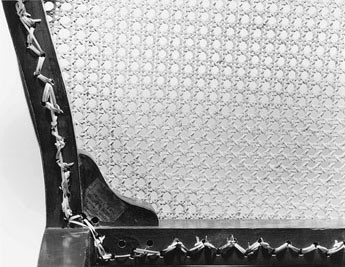
Detail of the underside of the seat of the armchair illustrated in fig. 20. (Photo, Gavin Ashworth.)
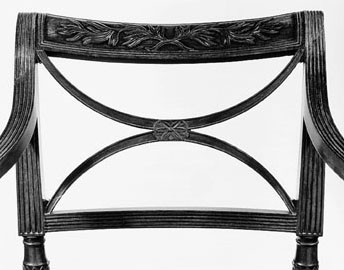
Detail of the back of the armchair illustrated in fig. 19. (Photo, Gavin Ashworth.)

Detail of the back of the armchair illustrated in fig. 20. (Photo, Gavin Ashworth.)

Scroll-back side chair, New York City, 1810–1820. Mahogany. H. 32 3/4", W. 17 7/8", D. 16 3/4". (Courtesy, Museum of the City of New York, gift of Berry B. Tracy; photo,Gavin Ashworth.)

Music stool labeled by Ernest F. Hagen and inscribed in pencil “1901/Dr H (illegible),” New York City, 1901. Mahogany with oak. H. 32 1/4", W. 18 1/2", D. 17". (Courtesy, The Collection of The Newark Museum; photo, Gavin Ashworth.)
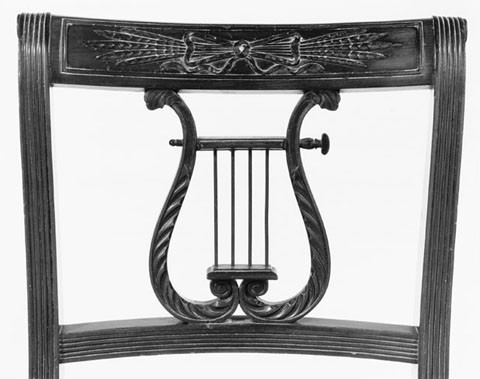
Detail of the back of the music stool illustrated in fig. 25. (Photo, Gavin Ashworth.)

Detail of the Hagen brand on the block of the music stool illustrated in fig. 25. (Photo, Gavin Ashworth.)
To have an American house, furnished in the American manner with furniture of American design and manufacture—that is the ambition of many a good American housewife. And when it is achieved she has a home of great simplicity and charm, of comfort and good taste.
Perhaps the most distinctive type of American furniture is that which came to us originally from the workshop of Duncan Phyfe, a New York City cabinetmaker. Although a Scotchman by birth, Phyfe may rightly be called America’s foremost furniture designer and maker.
Mrs. Charles Bradley Sanders,
How to Know Good Furniture
(New York, 1924)
Is it Phyfe? is a question contemporary consumers often ask furniture showroom staff, interior designers, and antique dealers while shopping for furnishings. “Phyfe” is more than the surname of the best-known nineteenth-century New York City furniture craftsman, Duncan Phyfe (1768–1854). Through the efforts of generations of dealers, collectors, curators, and furniture manufacturers, “Phyfe” has become a generic term used to identify American-made furniture in the “antique” or neoclassical style, inspired by the forms and ornament used in classical Greece and Rome. Manufacture of furniture in the neoclassical taste continued well into the mid-nineteenth century. Renewed interest in Phyfe’s furniture, and in neoclassical furniture generally, began with the colonial revival movement in the latter half of the nineteenth century, from the old-time kitchens at various Sanitary Fairs during the Civil War era to the celebration of the nation’s centennial in 1876 and the subsequent centennials of the ratification of the Constitution and the inauguration of Washington. Even today, neoclassicism continues as a focus of decorating trends. This article explores the continuing challenge of separating the products of the shops of Phyfe and his early nineteenth-century New York contemporaries from later copies and adaptations.[1]
Duncan Phyfe arrived in New York City from Albany not later than 1792, when he became a member of the General Society of Mechanics and Tradesmen of the City of New York, a charitable and educational organization that gave the newcomer a network of contacts and prospective customers. The New York Directory and Register, for 1793 listed him as “Duncan Fife,” joiner, at 2 Broad Street, not far from Federal Hall where George Washington’s first inauguration had been held four years earlier. There he shared quarters with turner and rush-bottom chairmaker Vincent Tillou. By 1795, Phyfe had moved his shop to Partition (now Fulton) Street, where he conducted business until his retirement in 1847 and continued to live until his death seven years later. Over the course of his fifty-five-year career, Phyfe employed family members as well as journeymen and apprentices, whose numbers and names have largely escaped the historical record.[2]
In the absence of any surviving daybooks or ledgers, a group of approximately forty bills from Phyfe identifies some of the shop’s clientele and suggests the diversity of woods available, as well as the variety of furniture forms produced. Although only a few labeled examples of his furniture are known, Phyfe achieved considerable celebrity in his lifetime. Attesting to the high reputation of his products was an advertisement for the sale of used household furnishings that appeared in the February 20, 1817, issue of the New York Evening Post. The advertiser noted that the sale “consists of almost every article necessary for a small and genteel family, and is but three years old; was made by Phyfe and other respectable persons.” In 1840, Phyfe was among the cabinetmakers and furniture manufacturers who endorsed products of varnish manufacturer P. B. Smith & Co., 139 Maiden Lane, New York, in an advertisement published in the Alexandria Gazette and Virginia Advertiser. The fifth edition of Wealth and Biography of the Wealthy Citizens of New York City (1845), compiled by Moses Yale Beach, noted that Phyfe “Commenced in Fulton street, where he now is, a poor cabinetmaker, and has now the largest and most fashionable establishment in the county.”[3] His reputation today as an innovator in design and as a producer of furniture of the highest quality is largely due, however, to the promotional efforts of New York cabinetmaker Ernest F. Hagen (1830–1913).
Hagen, described in an obituary published in the New York Times on June 8, 1913, as an “expert appraiser and collector of art objects,” was a native of Hamburg, Germany. He and his family arrived in New York in June 1844. The following year, his father apprenticed him (at the age of fifteen) to a firm of German cabinetmakers, Krieg and Dohrmann, at 106 Norfolk Street, where he remained until 1853. Hagen was too young to have been a journeyman in Phyfe’s shop, which closed in 1847. After leaving his masters, he worked in several shops along Broadway below Bleecker before securing employment with the two hundred-man manufactory of Charles A. Baudouine at 335 Broadway (fig. 1).[4]
When Baudouine closed his business in 1855–1856, Hagen traveled west, working in Milwaukee, St. Louis, and New Orleans. He returned to New York in 1858 and formed a partnership with his old friend and shopmate, J. Matthew Meier, under the name of Meier and Hagen. In 1867, they moved to 213 East 26th Street, where they built a dwelling that included living quarters for Hagen and his family and a shop. The Meier family lived next door. Meier and Hagen specialized in the manufacture of extension dining tables for the wholesale trade during the first years of the partnership, when they worked at the bench with two or three hands and earned little more than their expenses. By 1870, the firm employed ten men, on average, and had no mechanized equipment. The partnership continued until 1888, producing a wide range of furniture including “Eastlake” and “Clarence Cook” bookcases and designs by Louis Comfort Tiffany, for whom they produced a variation on the ladder-back chair as recorded in the order books on May 7, 1885—“10 Maple Colonial Dining Chairs with webbing seats in leather and leather backs to Special Design,” plus two armchairs.[5]
Meier and Hagen also copied pieces from such fashionable New York furniture and decorating firms as Herter Brothers, Leon Marcotte, and Sypher and Co. For other clients, Hagen’s shop altered genuine eighteenth-century antiques, like a slant-front desk that received “2 new webb feet” and a carved shell on the fallboard. The desk cost Hagen $10.00, and the alterations totaled $38.75; he charged his client $95.00. Meier and Hagen refurbished and sold old furniture described in the firm’s order books as “Chippendale,” “Sheraton,” and “Phyfe’s Antique,” as well as reproductions in “Phyfe’s pattern.” On June 15, 1886, Meier and Hagen billed a client for “1 Phyfe’s Arm Chair (antique) in XVI Century old blue plush & fancy bronze nails 35.00, 1 small chair to match (reproduction) 22.00.”[6]
The Meier and Hagen shop probably used old wood to fabricate the swivel-top card table illustrated in figure 2, which has a partially legible paper label. The lower edge of the skirt has an empty channel, where a string of brass was probably once inlaid. Hagen noted in a 1905 newspaper interview that “the ruins of irreparable damaged old pieces furnish the modern cabinetmaker with the very best seasoned mahogany.”[7] Although the guilloche and waterleaf carving on the legs and supports (fig. 3) are related to motifs used on early nineteenth-century neoclassical furniture, the combination is not traditional. When viewed under ultraviolet light, the top and base of the table fluoresce differently, indicating the presence of a shellac on the upper portion and a resin varnish on the base.
After Meier’s withdrawal from the firm, Hagen continued the business as “Ernest F. Hagen, cabinetmaker,” until about 1905, when his eldest sons Frederick E. and Henry A. took over. One antique that passed through the firm after Meier’s withdrawal is a dressing glass (figs. 4-6), which Hagen noted was “at one time the property of General Van Horne [1746–1801]/bought at the ‘Floyd’ sale/on west 12 Street New York City/March 1890.” Hagen purchased the dressing glass at the sale of “colonial relics” belonging to the late Benjamin Floyd, 124 West 12th Street, Manhattan, held on March 27, 1890. According to the New York Times’s coverage of the sale, “Mr. Floyd was the grandson of Gen. David Van Horne of Revolutionary fame and had many mementos of that distinguished gentleman.” Hagen apparently got a bargain, for “low prices prevailed all through the sale.”[8]
Hagen is perhaps best known today for his “Personal Reminiscences of an Old New York Cabinetmaker,” excerpts of which were published in Antiques in December 1943 and November 1963. He illustrated his memoirs with sketches of furniture forms, including one that documented the infringement of his former employer, Charles A. Baudouine, on John Henry Belter’s patent for manufacturing laminated chair backs. As Hagen’s interest in Duncan Phyfe grew, he sought out Phyfe family descendants and relevant documents. Following an interview with Phyfe’s nephew, Duncan Phyfe of Jersey City, New Jersey, Hagen noted that the younger Phyfe recalled that his uncle was “always working . . . and after retiring from business kept . . . at the bench making small things for his folks which they still preserve.” A dressing glass that descended in the family of Eliza Phyfe Vail is one such item (fig. 7). By 1894, Hagen’s observations were being quoted in newspaper articles on old New York furniture, such as one published in the August 12 issue of the New York Sun (fig. 8). He recorded his findings in notes transcribed as “Personal Experiences of an Old New York Cabinet Maker” and “Duncan Phyfe Notes.” These documents and later versions of them (all in the Winterthur Museum Library) provided the basis for most twentieth-century knowledge about Duncan Phyfe.[9]
The popularity of the Hudson-Fulton Exhibition, held at the Metropolitan Museum of Art in 1909, and the first major exhibition to display American decorative arts along with American paintings and sculpture, encouraged the collection of what had been considered “used furniture.” Included was a collection of furniture attributed to the Phyfe workshop, assembled by R. T. Haines Halsey (1865–1942) with the assistance of Ernest F. Hagen. Through Halsey, Henry Watson Kent (secretary of the board of trustees of the museum and organizer of the American section of the show) obtained Hagen’s biographical notes on Phyfe and used them in his catalogue essay on American furniture. Kent also requested Hagen’s help in identifying the furniture assembled by the exhibition committee.[10]
Collector Francis P. Garvan acquired much of the Halsey collection in 1929 and presented it to Yale University the following year. A second Metropolitan Museum of Art exhibition, “Furniture Masterpieces of Duncan Phyfe,” which was organized by Halsey and Charles Over Cornelius in 1922, was the first museum exhibition devoted to the work of a single American cabinetmaker. Among the lenders were Mrs. Giles Whiting and Mrs. Harry Horton Benkard, both collectors. The exhibition and its companion publication, with measured, detailed drawings by Stanley J. Rowland, stimulated additional interest in Phyfe and his furniture.[11]
Included in the 1922 exhibition was one of a pair of New York five-leg card tables with double elliptic tops owned by Mrs. Harry Horton Benkard (fig. 9). It was illustrated in the accompanying publication as plate 20, but affixed to the underside of the top is a Hagen shop label (fig. 10). Are thistable and its mate genuine antiques, restored by Hagen, or were they made up from old wood in the Hagen shop? The back and underside are mahoganized and varnished, treatments rarely encountered on period furniture, which suggests Hagen-shop manufacture. The method of attachment of the front legs to the skirt core also points to a late nineteenth- or early twentieth-century date of manufacture, when compared to that of a card table bearing the label of John T. Dolan’s cabinet warehouse, 30 Beekman Street, 1809–1813 (fig. 11). Regional preferences employed by the Dolan shop include a veneered top over a joined core (intended to prevent warping), a treble elliptic shape for the top, and finely turned and reeded legs (fig. 12).
Perhaps exhibited, but not illustrated in the 1922 publication, was a square sofa from the Benkard collection (fig. 13). Although the basic frame dates from the early nineteenth century, the sofa has been extensively restored to repair a major break in the front seat rail. Its medial braces have been moved to accommodate pine reinforcements on the inner face of the front seat rail, and the right rear leg has been pieced at its base. Although the absence of reeding on the back of the center front legs suggests that they are original and period, the casters are not original, and the restorer shaved the front feet to make them fit. The inner face of a rear leg is inscribed “HAGEN/OCT. 1922/FEH,” for Ernest F. Hagen’s son and successor, Frederick E. Hagen (1868–1948). Presumably the younger Hagen undertook the work so the sofa could be included in the 1922 “Furniture Masterpieces” exhibition as a “Phyfe” piece.
With the opening of the American Wing of the Metropolitan Museum of Art in 1924, furniture manufacturers introduced reproductions of museum objects. R. T. Haines Halsey acted as an advisor for The Company of Master Craftsmen, Inc., a subsidiary of W. & J. Sloane (founded by William Sloane Coffin), active in Flushing, Queens, from 1925 to 1942. They produced “registered reproductions” for the growing middle-class market. Their advertisement for a Phyfe-style sofa, which appeared in the September 1926 issue of Antiques, was obviously intended to reach collectors (fig. 14). Somewhat more modest was the “Monticello—A Duncan Phyfe Adaptation” dining room suite available through the 1930 spring-summer catalogue of Sears, Roebuck and Co., with side chairs at $6.95 (fig. 15). Although the chair is relatively accurate (except for the stretchers), late nineteenth- and early twentieth-century innovations are evident in the china closet form and the novel application of broken-arch pediments to the case furniture in
the suite.[12]
Museum exhibitions and publications during the 1930s continued to focus attention on Phyfe. In 1934, Joseph Downs and Ruth Ralston organized an exhibit at the Metropolitan Museum of Art titled “New York State Furniture,” which included pieces labeled by and attributed to Phyfe. Then in 1939 Nancy McClelland published Duncan Phyfe and the English Regency, 1795–1830, which quickly became the “canon” of Phyfe scholarship and attributions.[13]
Looking for “Phyfe,” that is, distinguishing period furniture from later reproductions and adaptations, is not particularly easy. During Phyfe’s working career, New York cabinetmakers began to utilize ready-cut sheets of veneer, foot-powered mortising machines, and circular saws. In addition, later handcraft shops, like that operated by Hagen (which coexisted with both local and distant midwestern and southern furniture factories), continued to use hand-sawn and chiseled dovetails and mortise-and-tenon joints rather than machine-cut joints and dowels, and to carve decorative details by hand. To differentiate such handcrafted items from period originals, one must evaluate the artistic handling of the form and its ornament, check for evidence of use commensurate with the purported age of the object, and identify the effects of age on its condition.
The difficulties of such evaluations are illustrated by two curule-based side chairs (figs. 16, 17). Both are part of a large suite of seating furniture from the family of New York merchant Thomas Cornell Pearsall (1768–1820), who maintained a house at 43 Wall Street and another called “Belmont” at 57th Street and the East River. Based on the folding chair of the Roman magistrate, most curule or Grecian cross chairs of this type are attributed to Phyfe’s shop. A sketch of a similar chair is thought to have accompanied a letter from Phyfe to his Philadelphia patron Charles N. Bancker about 1816. La Mesangere’s Meubles et Objets de Gout (1800), however, illustrates a stool derived from the Roman curule with the cross at the front, and the 1808 Supplement to the London Chairmakers’ and Carvers Book of Prices for Workmanship—the probable design source for the New York Grecian chair—illustrates two curule stools. New York chairmakers simply added a square back with an “ogee splat” and a single rosette.[14]
Although both chairs are constructed in similar fashion, the one branded “h. dorr” (figs. 17, 18) has slightly different proportions and carving details. Did chairmaker Dorr, who appeared in city directories from 1842/43–1862/63, make the branded chair and its mates among the Metropolitan Museum of Art group to extend the original set? Is the chair a survival, or a revival, of neoclassical design?
Ernest F. Hagen gathered materials about Duncan Phyfe and examples of furniture that he attributed to the Phyfe shop to document the man and his craft. His clients had more diverse motives for acquiring “Phyfe” furniture. To some, Phyfe, despite his post-Revolutionary working period, exemplified the self-reliant, preindustrial “colonial” artisan-craftsman. (The term “colonial” was loosely used well into the twentieth century to describe the period before the onset of modernization, about 1840.) To others, maintaining and adding to collections of family furniture reinforced their notions of superior social position in a rapidly changing society. Others simply found neoclassical designs graceful and artistic.
Two scroll-back armchairs illustrate such diverse motives. According to donor tradition, the chair illustrated in figure 19 and its mate belonged originally to diarist Philip Hone, who served as mayor of New York City in 1826. “Scroll sweep elbows” such as those used on these chairs cost eleven shillings (about $1.38), according to The New-York Revised Prices for Manufacturing Cabinet and Chair Work (1810). “Springing the front legs one way, each leg” was an additional six pence, and “preparing the front legs for lion’s paws, each” cost one shilling.
Mrs. W. Sheffield Cowles, sister of President Theodore Roosevelt, probably ordered the Hagen chair with turned legs illustrated in figure 20, which is part of a set of four armchairs and two side chairs with a matching settee. Members of the Roosevelt family patronized Meier and Hagen frequently during the 1880s, often buying antiques or neoclassical-style furniture. The chair and its mates were sold during the dispersal of the Cowles estate, at Farmington, Connecticut, on May 30, 1987.[15]
To supply such a chair, Hagen bought unfinished frames from a specialist chairmaker like Jacob Dieter. Listed in the Meier and Hagen order books, Dieter charged $9.50 each for “Phyfe’s Antique” mahogany chair frames. Workers in the Hagen shop carved, caned, and varnished the frame and the completed chair sold for about $25.00.
Both construction details and overall appearance mark the Hagan chair as a reproduction, although it may have been based on a period armchair he owned. Particularly significant is its lack of medial braces (fig. 21), which are dovetailed into the front and rear seat rails on period examples like Philip Hone’s (fig. 19). “Sweep” or curved braces were standard on New York chairs after 1802. Comparison of the crest rail carvings (figs. 22, 23), which Elizabeth Stillinger has called “seaweed,” reveals subtle differences in modeling and design, with the 1905 carving lacking the crisp detailing of the earlier work.[16]
English lyre-back chairs were exported to the United States by the mid-1790s; however, the earliest evidence of their production by an American cabinetmaker is the aforementioned sketch (also depicting a curule chair) attributed to Phyfe. The lyre-back chair in the sketch has hairy shanks, lion’s paw feet, and a carved crest rail. According to the fee schedule published in The New-York Book of Prices For Manufacturing Cabinet and Chair Work (1817), the labor charge for making a basic lyre banister was seven shillings, eight pence; stringing the lyre with brass cost an additional three pence per string (fig. 24).[17]
In 1901, the Hagen shop adapted the back scroll and lyre components to a music stool (fig. 25). Eliminating the rear legs might have weakened the joint between the side seat rail and the rear stile, so the chairmaker improvised truncated extensions. Ultraviolet fluorescence indicates that both shellac and natural resin varnish were used in different areas, and that a coloring agent was used to “antique” the carving on the crest rail (fig. 26). This finding suggests that the chairmaker used old components on an essentially new form. The stool is branded twice with Hagen’s shop name and address (fig. 27). A similar base, used for a mahogany swivel-top card table, has a printed Hagen label dated 1897.[18]
As this survey has illustrated, differentiating later handcrafted furniture from that made in the workshops of Phyfe and his contemporaries can be difficult in the absence of documentation. One also must keep in mind Ernest F. Hagen’s 1907 admonition that “from about 1840 to about 1865 a great deal of furniture was made there which is now sold for antique to such as don’t know any better.”[19]
The most comprehensive analysis of Hagen’s life and career is Elizabeth Stillinger, “Ernest Hagen—Furniture Maker,” Maine Antique Digest (November 1988): 8D–16D; a conversation with Ms. Stillinger following the publication of that article led to the exhibition proposal that became Is It Phyfe?
Stillinger, “Ernest Hagen—Furniture Maker,” p. 12D, fig. 14, illustrates the order book sketch for the desk and the list of alterations. Three of Hagen’s order books, dating from 1880 to 1886, are in the New-York Historical Society, New York. See Ruth Ralston, “Ernest Hagen’s Order Books,” Antiques 48, no. 6 (December 1945): 356–57.
Antiques 10, no. 3 (September 1926): 165. Spring and Summertime, 1930 Catalogue (Chicago: Sears Roebuck and Co., 1930), p. 576.
